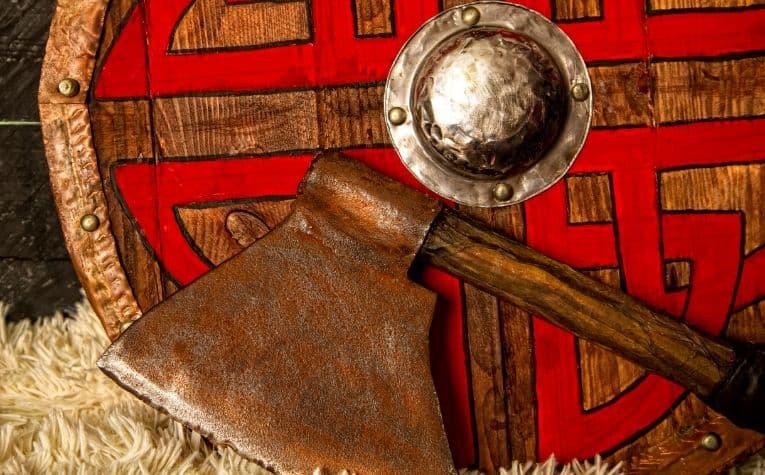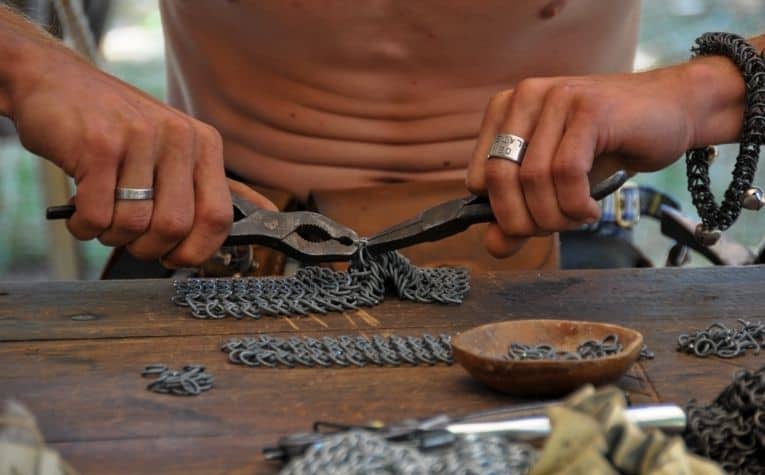By most accounts, the Vikings’ reign of power in Northern Europe ended by the middle of the 11th century.
Yet today, nearly a millennium later, programs about these Norse warriors are must-see television, and video games featuring Viking characters are top sellers.
And Viking paraphernalia has never been more popular, particularly authentic items with which they lived, worked, and fought.
Genuine Viking artifacts, including various types of weaponry and assorted jewelry, can be purchased by buyers ranging from Viking culture enthusiasts to serious antiquities collectors.
Viking beads can be had for less than a hundred dollars, while items like swords and axes can cost thousands.
The resurgence of all things Viking in popular culture today is a testament to their incredible influence over the peoples they conquered and those who learned of their exploits from afar.
More is being learned about the Vikings as excavations continue to unearth their secrets. For collectors, newly discovered troves offer tantalizing opportunities to acquire genuine Viking artifacts, but how?
The shield was one of the most important pieces of Viking equipment. See The Viking shield: Why is it round, wooden & painted? to learn more.
What Kinds of Viking Artifacts Can You Buy?

The iconic items in the world of Viking antiquities are the weapons that were used to besiege Northern Europe, namely swords and axes.
But the Vikings were also skilled jewelers, as evidenced by the exquisite gold and silver pieces they crafted.
These are the main categories of genuine Viking artifacts recovered since the end of the Viking Age in 1066:
- Weaponry – big-ticket items like swords and axes (only the heads have been recovered) are likely to cost upwards of thousands of dollars to acquire but would certainly be an impressive centerpiece around which to build a private collection
- Jewelry – most Viking jewelry was crafted from silver and gold, and among the items most commonly purchased are necklaces, armbands, rings, amulets, and pendants
- Tools and Implements – iron hoes and farming tools have been recovered and are popular items sought by collectors, as are personal grooming pieces like combs and scissors [1]
A lot of people wonder what the Vikings looked like. See The Viking Dress Code: What They Wore and How to learn more.
How to Buy Viking Artifacts that are Genuine and not Fake

With Viking artifacts’ popularity on the rise and buyers eagerly looking to add to their growing collections, counterfeiters and con artists are seizing upon opportunities to turn a quick profit by selling fake goods.
Many items are passed off as genuine Viking artifacts when they are not, and many unsuspecting buyers purchase fake items without ever realizing that they have been deceived.
To avoid becoming a fraud victim, following a few basic guidelines when considering a purchase of purportedly genuine Viking artifacts is important. Collectors should:
- Only buy artifacts from reputable sellers, whether they be auction houses or antiquities dealers
- Seek out metal testing reports whenever possible
- Look for sellers that offer authenticity certificates or guarantees
- Research items before purchasing (auction catalogs are a good resource for learning about certain types of objects)
The Vikings had a reputation for revelry. See What Did the Vikings Drink Out Of? to learn more.
Where can you buy genuine Viking artifacts be bought today?
Perhaps it is the way they burst onto the scene, seemingly out of nowhere, or how so many of them eventually settled in the same lands that they terrorized, but despite the relatively short period that the Viking Age lasted, the Vikings are among the most recognizable figures in the history of humankind.
Perhaps it is no surprise that articles from their heyday during the Middle Ages are in such demand.
For the average collector, there are three primary sources through which to acquire genuine Viking artifacts.
As is so often the case with nearly any type of transaction in today’s world, purchases can be made from the comfort of home through a computer or even a smartphone.
Auction Houses
Antiquities are more likely found at reputable auction houses specializing in them.
Regarding genuine Viking artifacts, the best selections will be found at auction houses operating in the United States and England, as interest in Viking culture is high in these countries.
As a sign of the times, nearly all of them offer online bidding and secure shipping.
Aside from their impressive collections, auction houses also offer peace of mind by providing certificates of authenticity and guaranteeing that pieces are truly as they are described.
They also offer detailed catalogs (registration may be required) that provide descriptions and images of items up for bidding.
Here are a few online auction houses that offer bidding on authenticated Viking pieces:
- Artemis Gallery (United States) – based in Colorado, Artemis Gallery is one of the leading auction houses in the US dealing in antiquities. With a 100% money-back guarantee relating to the authenticity of pieces sold, collectors can rest assured that their acquisitions are genuine. [1]
- TimeLine Auctions Ltd. (United Kingdom) – this auction house has, through the years, acquired exquisite Viking pieces, particularly in the category of jewelry and handcrafted implements like combs, tweezers, and the like. For significant purchases, TimeLine even offers discrete security details to oversee the transfer of particularly valuable items to their new owners.
Counterfeit goods are always a concern when it comes to the sale of antiquities, so too are legal concerns.
Stolen or illegally excavated items can be confiscated and involved parties prosecuted (this includes sellers and buyers).
Aside from written guarantees pertaining to authenticity, TimeLine Auctions also certifies that all pieces have been legally sourced and that their sale is permissible under international laws. [2] [3]
Antiquities Dealers
Aside from auction houses, antiquities dealers represent trustworthy sources for genuine Viking artifacts for private collectors.
The more established and reputable dealers will even offer certificates of authenticity and guarantees similar to those offered by international auction houses.
Peace of mind cannot be understated when it comes to Viking-era pieces’ authenticity, as even experts have been fooled by fakes.
Another concern that arises when purchasing artifacts is whether they can be legally sold and purchased.
It would, therefore, be prudent to seek out respectable dealers to minimize the potential for fraud.
Here are a few prominent antiquities dealers offering genuine Viking artifacts for sale:
- Fagan Arms – with over 40 years of experience dealing in antiquities, this US-based dealer offers an extensive collection of Viking artifacts, including jewelry, beads, and small weapons. Pieces are sold with accompanying certificates of authenticity. [4]
- Paleo Direct – this dealer in California offers a small but impressive collection of Viking artifacts (consisting mostly of weaponry) and backs each piece with a guarantee of authenticity. [5]
Private Sellers
The words “buyer beware” perhaps have no more significant meaning than when dealing with private antiquities sellers.
This is not to say that all private sellers are to be distrusted.
Still, unlike auction houses and antiquities dealers that have reputations and exclusive client bases to uphold, individual purveyors simply lack the expertise or resources to thoroughly research and validate the authenticity (and legality) of a particular item.
However, online platforms provide tremendous convenience and make purchasing Viking artifacts as easy as ordering pizza or a new pair of shoes.
In addition, these sites offer an impressive array of items (mostly small ticket) ranging from amulets to small arms.
- eBay – the e-commerce site that started it all is also a one-stop-shop for Viking articles, with thousands of offerings listed by private sellers worldwide. eBay is a good option for budget-conscious collectors who are willing to assume the risk that the $20.00 10th century Viking amulet they just purchased might not actually be from the 10th century or even Viking in origin.
- Etsy – another e-commerce platform with a growing portfolio of Viking artifacts is the hobbyist-oriented Etsy site. Etsy may be an ideal gateway for newbie collectors looking to get their Viking collection started without breaking the bank with items like pendants, amulets, and small hand tools and weapons.
From sentimental trinkets to centerpieces of private collections, genuine Viking artifacts can be acquired securely and worry-free with a bit of research and simple prudence.
References:
[1] Live Auctioneers
[2] Artemis Gallery
[3] Timeline Auctions
[4] Art Net
[5] FaganArms
[6] Paleo Direct
